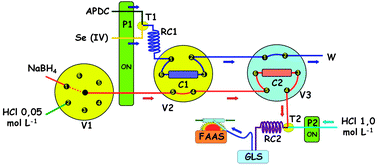An on-line preconcentration system for the determination of selenium in seawater samples
Abstract
A flow injection system was developed for the preconcentration and determination of selenium in

* Corresponding authors
a
Universidade Estadual do Sudoeste da Bahia, Laboratório de Química Analítica (LQA), Campus de Jequié, Jequié, BA, Brazil 45206-510
E-mail:
vlemos@uesb.edu.br
Fax: +55 73 35289630
A flow injection system was developed for the preconcentration and determination of selenium in

 Please wait while we load your content...
Something went wrong. Try again?
Please wait while we load your content...
Something went wrong. Try again?
V. A. Lemos and M. V. Maciel, Anal. Methods, 2013, 5, 4501 DOI: 10.1039/C3AY40272J
To request permission to reproduce material from this article, please go to the Copyright Clearance Center request page.
If you are an author contributing to an RSC publication, you do not need to request permission provided correct acknowledgement is given.
If you are the author of this article, you do not need to request permission to reproduce figures and diagrams provided correct acknowledgement is given. If you want to reproduce the whole article in a third-party publication (excluding your thesis/dissertation for which permission is not required) please go to the Copyright Clearance Center request page.
Read more about how to correctly acknowledge RSC content.
 Fetching data from CrossRef.
Fetching data from CrossRef.
This may take some time to load.
Loading related content
